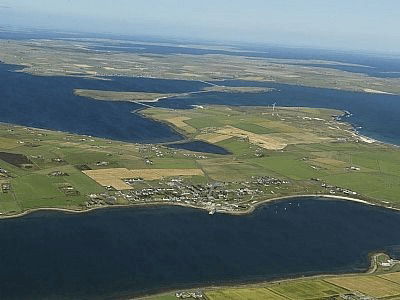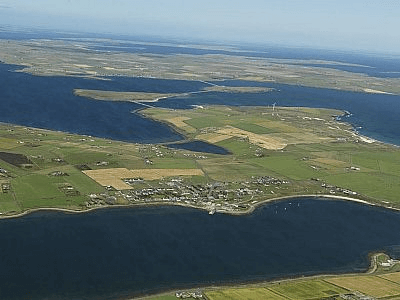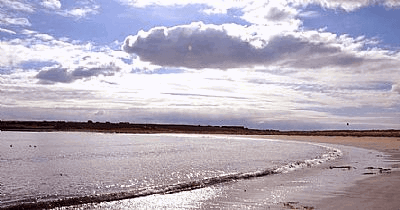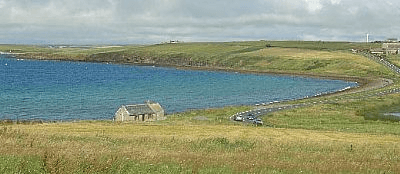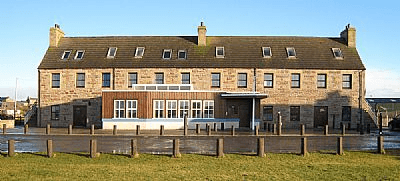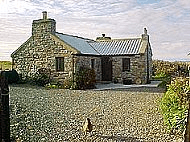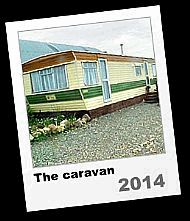OLD BURRAY
Early Times
The island was named Burray or "Broch island" by the vikings. At that time, the brochs on the north coast facing out over Weddel Sound would have been imposing structures and obvious reference points from either land or sea.
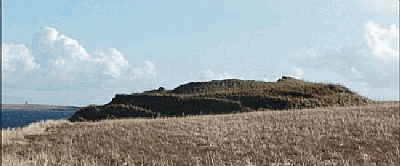
East Broch Northfield Burray.
Although these brochs only appear now as large grass covered mounds, when they were excavated in the 19th century, visitors would take tours around the inside. The excavations were however not done in a manner which would today be considered proper and so much information that could have been obtained has been lost. The brochs have also been robbed to provide building stone, so little of value remains. In 1940 the Northfield gun battery was built partially into the side of the West Broch.
One hundred yards to the west of the East broch are the remains of a chambered "short horned" cairn but this was levelled by the farmer in 1863. The destruction was observed however and the cairn was seen to be fourteen feet long, eight feet wide and five to six feet high.
It was divided into three compartments and contained a large number of unburnt human skeletons and seven dog skeletons.
On the west side of the island, just round the coast from the east and west brochs is Bu Sands where sand extraction has unearthed many finds from the iron age period, sometimes picked up by those who were just out for a stroll along the pleasant beach.
There has been a house at The Bu since viking times or possibly earlier and much of the early history of Burray is said to be just the history of the Stewart's who owned it. The present house at The Bu was built in 1749.
20th Century Burray
The last one hundred years have seen greater and more rapid changes in Burray than any previous period. Due to high taxes and death duties, many estates in Scotland were being broken up and sold. Burray was no exception to this and all of the farms along with almost all of the houses on the island were sold to the tenants. The island was no longer the property of a single estate.
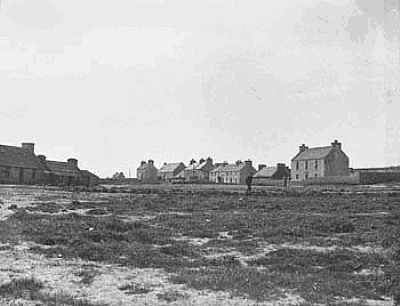
Burray Village in the early 1900s
The biggest changes though were due to the use of Scapa Flow as the northern base of the fleet during both world wars.
During the First World War, block ships were sunk in the eastern entrances to the 'Flow'. Although this was necessary for the defence of the fleet, it was also the final blow for the fishing industry in Burray which could not now easily access the fishing grounds in the North Sea. Despite many representations after the war, these blockships were not removed and so the industry never recovered.
The Second World War was the time of greatest change on the island. After the sinking of the Royal Oak by the U47 in October 1939, Churchill ordered the permanent closure of the eastern entrances to Scapa Flow.
Prisoners of War were not allowed to be used for war work. So the Barriers were designated as 'causeways' connecting the south isles. This meant Prisoners of War were allowed to work on their construction.
The contractor engaged to construct the 'causeways' was Balfour Beatty. They had two construction camps, one near Burray Village and another in the north by Weddel Sound. The prisoner of war camp was close to the northern Balfour Beatty camp.
No 3 Barrier was to be built across Weddel Sound and No 4 across Water Sound.
Quarries and blockyards were constructed at both ends of the island and railways were built to transport the rock and the blocks to the cranes. An electricity generating station was built, a reservoir was constructed on the links and water was pumped from Ecna Loch.
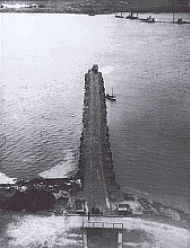
No 4 Barrier being constructed over Water Sound
The final closure on No 4 Barrier was achieved in June 1943 although the official opening ceremony was not performed until May 1945.
In a few short years, Burray had been transformed from a small farming and fishing community, through the influx of workers, prisoners and heavy equipment into one that was now linked to the mainland of Orkney. People would now be able to live in Burray while being employed in Kirkwall or elsewhere on the mainland.
BURRAY INDUSTRIES
Agriculture
Burray is a largely agricultural island with livestock farming being the mainstay of the industry.
Until recent times and with the exception of The Bu farm, the agriculture of Burray remained very basic and unimproved throughout the years. Bere barley and black oats were grown but accounts of the state of some of these crops are, to say the least, not flattering to the farmers.
To be fair to the farmers however, they were at the beck and call of the laird at all times and so time to work their own land may have been limited.
In the early 18th century, potatoes and turnips were introduced and potatoes in particular became an important part of the diet. Unfortunately it was some time before the value of turnips as livestock fodder was utilised.
By the early 19th century, the quality of the cattle on the island had improved from the earlier small, thin beasts and they were of sufficient quality to make dealers from Aberdeen consider it worthwhile to travel up and purchase cattle in Orkney.
This improvement in the cattle was due to improved breeds being introduced from further south and to the eventual use of turnips as winter feed so that the cattle could thrive all year round in the mild climate. This was the beginning of the improvement of orkney cattle which has resulted in Orkney beef being famed for high quality throughout the country.
When you find yourself in a queue on the barriers behind a gigantic green John Deere tractor that seems to be the size of a block of flats, it is hard to believe that it was not until 1943 that the first tractor was purchased by a Burray farmer and that there were no proper roads on the island until the 20th century.
The Kelp Industry
Seaweed has been used in Burray as a fertiliser and dressing for the land for centuries but in the 18th century, import duties and wars created a high demand for potash and soda made from kelp for use in the manufacture of soap and glass. The Orkney landlords realised that a great deal of money could be made from kelp and Burray was not alone in making the most of this opportunity.
Kelp production also fitted well into the farming year as the harvesting of the seaweed and the production of the kelp in kilns took place during the summer months.
The seaweed was cut at low tide when the cutters could wade out to the kelp beds where they would work for hours waist deep in water. The harvest was then hauled above the high water mark where it was left to dry before being moved to the kilns where it was burned for 8 hours to produce the kelp. These kelp kilns were merely shallow, stone lined pits in the ground. The resulting liquid was then left to cool and set before being broken up and shipped south for processing.
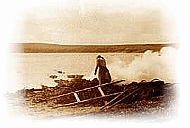
Kelp burning on the beach
By 1800, kelp accounted for 67% of all the exports from Orkney. But by 1830 the lifting of tarriffs on foreign soda and potash made imports cheap and although kelp continued to be produced for a few more decades, it ceased to be a major occupation in Burray.
Unfortunately the large profits to be made from kelp had led to neglect of the agricultural land with much of the population spending a great deal of their time in gathering and burning kelp so that after the decline of the kelp industry it took a long time to return the land to its previous fertility.
Seaweed is still occassionally collected from the beaches after storms for use as fertiliser on local farms.
Fishing
As a small island surrounded by fertile seas, fishing has always been important to Burray, although most people always combined fishing and farming.
In the 18th century, as now, lobsters were exported south from Burray and cod fishing was increasing in importance.
By the early 19th century however, the herring fishery was starting to expand rapidly and by the middle of the century it was a very important industry with most families in Burray engaged in one way or another with the fishery. The men crewed the boats while the women worked gutting, salting and packing the herring at the herring station which is now The Sands Hotel.
Rather surprisingly, given the amount of activity in the industry, construction of the pier in Burray village did not start until 1902 and it took a long time to complete.
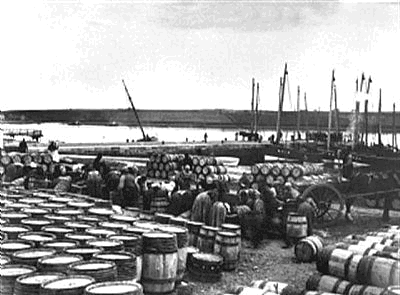
A busy scene at Burray in the 19th century.
The fishing industry of the island led in the 1870s to the establishment of Duncan's boatyard which carried on making boats which were generally considered the best that could be had, until the yard closed in 2001. Even today, the line "Constructed by Duncan's of Burray" can add to the sale price of any boat.
BURRAY NATURE
For a small island, Burray has a rich and diverse variety of plants, animals and birds.
Plants
In spring and summer,the roadside verges are awash with colour as a variety of plants thrive and bloom.
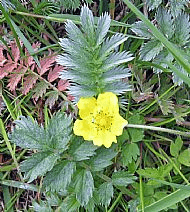
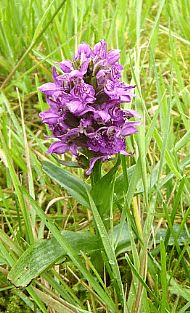
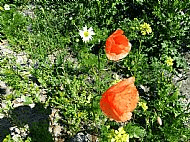
Silverleaf, Orchids and Wild Poppies and many other plants grow along the roadsides.
Although wild flowers grow in profusion all over Burray, it is probably on the sand and dunes at No 4 Barrier beach and at Bu sands that the flora really excels itself.

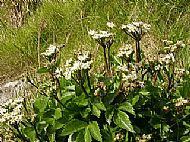
The rare Oysterplant and Scots Lovage grow at No 4 Barrier beach
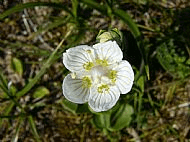
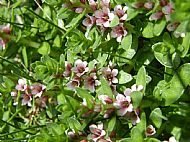
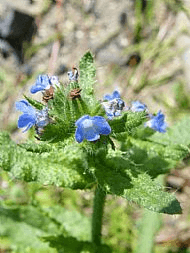
Grass-of-Parnassus, Sea Milkwort and Vipers Bugloss are amongst the plants to be found at Bu Sands.
Insects
Burray has fairly few varieties of butterfly but the dunes at No 4 Barrier are one of the few places to see the Dark Green Fritillary


Dark Green Fritillary Common Blue
Common Blue, Small Tortoiseshell, Red Admiral and Painted Lady butterflies are also abundant.
Moths include The Herald, Poplar Hawk, Pale Shouldered Brocade and Common Wave among many others.
The rare Great Yellow Bumble Bee also lives here.
Sea Life
Being an island surrounded by seas offering many different types of environment from the relatively calm and shallow waters of Scapa Flow to the vast expanse of the North Sea, Burray has a wide variety of sea life.
The marine mammals are the most spectacular although some are more difficult to see than others.
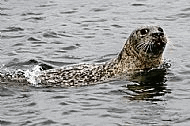
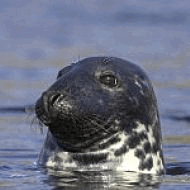
Common and Grey Seals abound and can easily be seen around Hunda
Porpoise and Dolphins are not quite so easy to see but with a bit of persistance, sighting them is not that difficult. A simpler way to see them though is to take a trip across The Flow towards Flotta or Hoy or on The Pentalina on the trip to or from Gills bay. There is a good probability of seing some at some point during the trip. It is best however to go when the sea is calm so as to be able to observe them.
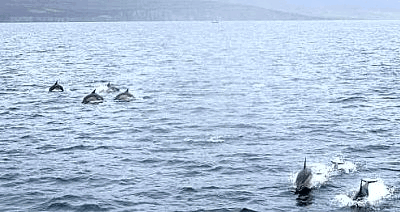
It is much easier to get a good view of cetaceans from a boat.
Other types of whales can be seen around Burray. The two photographs below were taken from the "Shiela C". This is the boat which Magnus Spence uses to give trips around Scapa Flow to see the wartime remains or the natural history. Good though Magnus is, he can't guarantee always seeing Humpback whales or being followed by Killer whales!
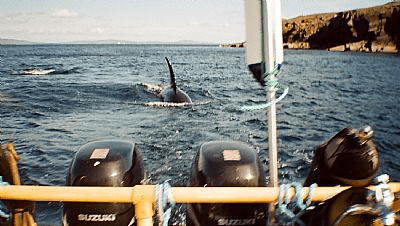
The "Shiela C" being followed by a large Killer Whale.
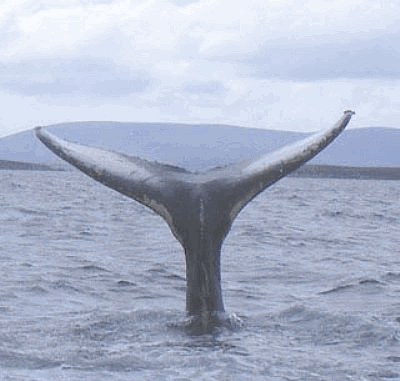
A Humpback Whale doing a spectacular dive in Scapa Flow.
Minke Whales are also common visitors as well as the Basking Shark - the second biggest fish in the world.
Land Mammals
Although Burray is rich in the variety of its plants and animals, there is not a great variety of land mammals on the island. Rabbits are of course plentiful everywhere but hares, which are common on Mainland Orkney have not made it to Burray. Fortunately, the newly arrived stoats do not seem to have got here yet either.
The quiet and uninhabited island of Hunda to the west of Burray is a good place to see Otters although an element of luck and a good deal of patience are needed to see these elusive animals.
There is however one species, unique to Orkney that flourishes here. This is the Orkney Vole. The Orkney Vole is a different species than the common vole of the rest of the UK and is more closely related to Scandinavian species. It is much larger than the common vole and it is the main prey of Hen Harriers and Short Eared Owls.
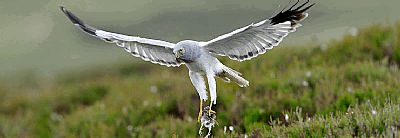
An Orkney Vole carefully hanging onto a Hen Harrier!
Birds
The bird life of Burray is far too interesting for this small page to be able to do it justice. Local birder Dave Wakefield, however, has a Burray Birding blog and a Bird list. This gives a much better idea of the birds of Burray than could be given on this page.
Just click on the link below to go to his site.
http://burraybirding.blogspot.co.uk/
There are however some birds which must be mentioned even in this small page. Although very rare in the rest of the UK, Hen Harriers are a common sight on Burray although to see one actually catching a vole as in the photo above, you need a bit of luck.The sight of a beautiful grey male quartering the fields in the early morning is one that nobody could forget. It is definitely a bird with a touch of magic.
Sparrow Hawks, Peregrin Falcons and Merlin can also be seen on the island and there seem to be an increasing number of Ravens who always loudly announce their presence.
The beach at No 4 Barrier in Burray is the home to the only Orkney breeding colony of the rare and graceful Little Tern.
Another rather iconic bird is the Short Eared Owl. These can be seen hunting or simply perching on fenceposts in broad daylight and they can be very obliging for photographers.

Short Eared Owl posing for a photograph.
Echa Loch has a variety of waterfowl including a pair of Mute Swans which nest each year right by the roadside.
Watersound and Echna Bay have sea ducks and both Red Throated and Black Throated Divers as well as the White Billed Diver which seems to have decided that Water Sound is home.
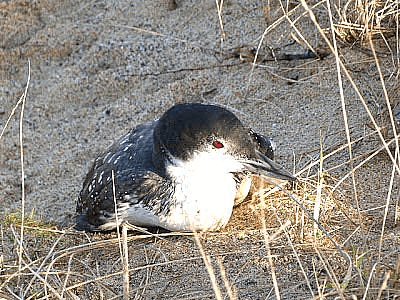
Though at home on the water, Divers are ungainly on land.
Because of the position of Orkney and the weather systems that pass through the area, rare migrant birds are more common than in most other parts of the UK, so there is always the excitement of knowing that almost anything is possible.
